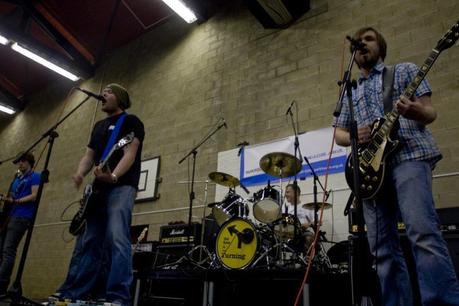Superficial Siderosis
2015-2016
Getting a diagnosis was the first step. After about a year of health deterioration, multiple hospital admissions and tests, I was physically and mentally exhausted. I missed so much time at work and was really struggling to sleep at night due to the endless symptoms. The anxiety was becoming a huge issue for me. What will happen next? Can things get better?
 New York 2011
New York 2011
I had been in generally good health for the past few years, so this was all kind of new to me. Having recently started a new job which I was still trying to get to grips with, my health plummeted. Firstly, my hearing suddenly went in my right ear and had a massive impact on my social life as I was a guitarist in a rock band. Losing a hobby and passion was one thing. Still, the fact it had happened only a few months after I lost my best friend and bandmate was emotionally crippling. I then began to suffer from my balance and had dizziness and headaches.
I was beginning to fall behind in work as I had not long started a new job and was still getting into the swing of things. I was now missing a lot of time from work to attend medical appointments and failing to get any answers regarding my health deterioration. I had seen many different specialists including, ENT, neurology neurosurgery, rheumatology and respiratory.

Over the previous few months, I had undergone multiple lumbar punctures which had shown my spinal fluid was discoloured. After having weekly trips to the hospital as an outpatient, I was finally admitted to the hospital as an inpatient to have more in-depth tests. My consultant told me the plan was to have an MRI brain scan. I was now raring to go and get some answers.
Getting the Right Tests
I recall lying in bed on the neurology ward at the hospital, and as the days went by, I became more anxious whilst waiting for the MRI scan. Told there would be a delay due to staffing shortages and an influx of emergencies, this really pushed my anxiety to the limits. People coming onto the ward were having scans as soon as they arrived, whereas I was still waiting for mine. After two weeks of staying in the ward as an inpatient, I broke down. The ward manager spoke with me in her office, and I explained how I felt. Soon enough, a doctor came to see me and told me she would contact my consultant (who was on annual leave) to see if he could push things forward.
The next day my MRI scan was carried out, and my consultant neurologist was back in work after his annual leave. He came straight to my bed with my MRI results along with the doctor who had contacted him to push my scan forward. I was told they now had an idea as to what is going on and that my consultant would contact an expert in London to get more information. My consultant told me he could see iron deposits on my brain, and I was told I would get a follow up as an outpatient once he had spoken to the expert in London. I was so relieved that something had been found, even though I was yet to be told what it was, or what it entailed; it was a huge weight off my shoulders.
The Diagnosis
A few days after I was discharged, I was called back into hospital as an outpatient. My consultant told me I had a very rare condition called Superficial Siderosis. While he had never seen a patient with it before, he was very aware of it. He told me he had spoken to his colleague in London who was knowledgeable in the condition, and he had been given advice on how to proceed. I was told there is no approved treatment for the condition in the U.K. and advised me to check out a small U.K based charity to find out more information.
My disorder was likely to be caused by the operation to remove a benign brain tumour that was carried out when I was 8 years old. My consultant then went on to say he will seek surgical opinion to see if it is possible to open the back of my head again to look for a bleed which had caused iron from the blood to settle over my brain, spine and spinal cord.
What is Superficial Siderosis?
Superficial Siderosis is a neurodegenerative condition which is caused by a slow, often intermittent bleed into the cerebrospinal fluid over a numerous amount of years. The brains capability to remove the full blood product eventually becomes overwhelmed, leaving iron deposits from the blood on the surface of the brain, spine and spinal cord. The iron is toxic to the nerves, causing mostly irreversible damage to them over time. The condition can be caused by previous surgery or trauma to the head or spine, and sometimes no cause is ever found. There is estimated to be around 1 in 3 million people worldwide who have the condition.
Following the diagnosis, it was back to work to carry on as normal (as I could). I resorted to playing acoustic guitar at open mic nights as I was struggling to hear multiple instruments at once. I now had developed unbearable tinnitus, and alongside the anxiety, I was really struggling to sleep. Again, the questions I was always asking myself ‘What would happen next?’, ‘Will surgery help my cause?’. I was not very aware of the condition myself, and my doctor had an idea but was not an expert.
Thankfully, I had looked up the Silent Bleed Superficial Siderosis Charity mentioned by my doctor and found people who were also diagnosed with the condition. There were very few people in the help group, and it began to daunt on me at how rare Superficial Siderosis is. People were mentioning a drug called deferiprone, which can cross the blood-brain barrier to remove the iron. However, some sufferers were having side effects from the medication or found that they saw no improvement in the amount of iron on their brain. Due to the slim prospects of the drug working, I thought I would mention it to my consultant as it gave me a little hope. My symptoms at this point were relatively stable, so I was hopeful I could get the drug and begin to manage the condition.
It was December 2016, and finally time for the follow up with my consultant neurologist, who greeted me alongside a consultant neurosurgeon. I was told they had discussed an operation to close the back of my head. Due to the way my bone had grown after the removal of the brain tumour 18 years ago in 1998, it would be a hazardous operation. I was told the back of my head could collapse and cause me severe brain damage or even death. The surgeon said he would still be willing to attempt the operation, but said it was up to me and I needed to be aware of the extremely high risks.
Together we decided that I would start deferiprone before any surgical intervention was attempted. I saw this as another considerable setback because knowing that blood could still be leaking into my spinal fluid. I could have even more iron build up on my brain, spine and spinal cord. Once again, my mood hit rock bottom.
In January 2017, my doctor told me he was still trying to get the drug which could help remove the iron from my brain. My anxiety flared up again as weeks were going by with no prospects of getting the drug approved. I wrote to my local member of parliament and explained the situation I was in; she kindly offered me her support and wrote to the drugs funding panel. I never knew how difficult it was going to be to get the drug I desperately needed, which was the only hope I had in fighting this condition.
Eventually, after being denied the drug, my consultant managed to obtain it. This perked my spirits up once again, but it still only gave me a slim chance to remove the iron from my brain and spine. Until then, I would continue to deteriorate. It was a rollercoaster of emotions, to say the least.
2018 to Present Day
I had multiple appointments with an occupational health physician. He diagnosed me with anxiety and depression due to my deterioration in health and worry about what was around the corner. My consultant neurologist had written to my place of work to advise he recommend I was unfit to work. In April 2018, I finished working. I had been in and out of the hospital so much, and there was no end to my medical saga. I also had to stop driving due to the many symptoms which would have made it dangerous to do so.
My social life has now crumbled even more, and my mobility has also gotten worse. I’ve gone from being a very outgoing person who loved to socialise, attend pub quizzes and play music, to spending a lot of time researching, and exercising to keep my health as good as I can.
In November 2018, I had an operation to seal the leak at the back of my head in which a PEEK (type of plastic) implant was used to fill the cavity. I had another lumbar puncture in 2019 that showed my spinal fluid is now completely clear, which I had never seen before. The fact it appears the bleed at the back of my head has now stopped was a huge lift, but my condition has only worsened. I am now wholly deaf, use a wheelchair to get about and am always in pain.
My mood is now more stable than it was, and I continue to take deferiprone in hopes of removing the iron from my brain and spine.
Sleeping at night is still tricky, as I always worry about the following day and what symptoms are going to develop next. I often get upset about seeing posts on social media about music and the things I used to love to do. At the same time, I like to see what is going on and think accepting the condition I have and how things are now is the best way to moving forward in life.




